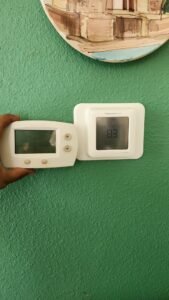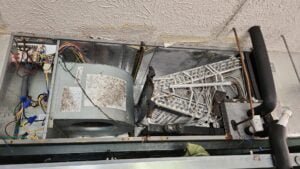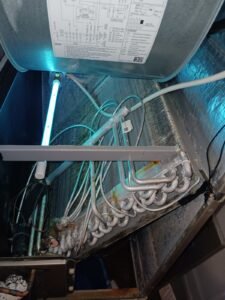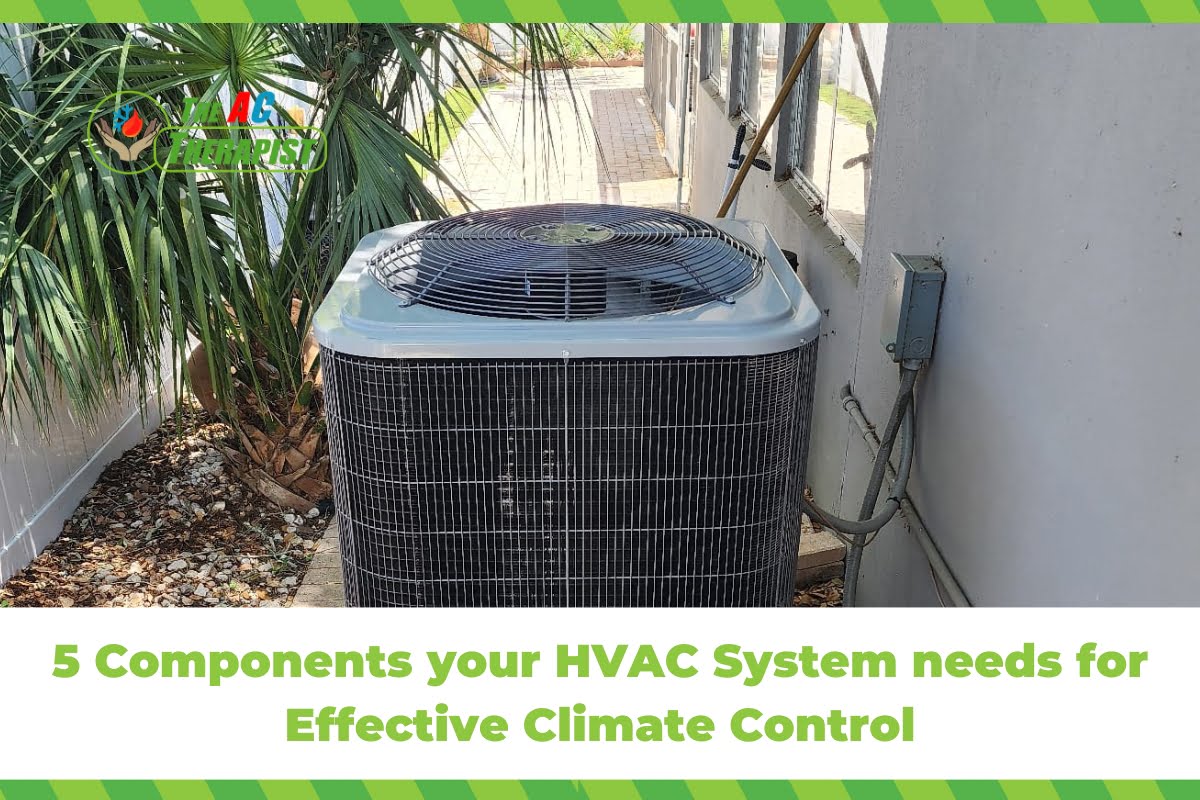5 Components your HVAC System needs for Effective Climate Control
In the realm of modern living, the HVAC system stands as an unsung hero, orchestrating the delicate balance between indoor comfort and outdoor elements. At the heart of this intricate interplay lie the HVAC system components, working in harmonious synergy to ensure efficient climate control. In this comprehensive exploration, we will delve deep into the core elements that constitute the backbone of your HVAC system. By understanding these components and their interactions, homeowners gain valuable insights into maintaining a comfortable and healthy indoor environment.
The Furnace: Warming the Core
The furnace, a cornerstone of heating, forms one of the pivotal HVAC system components. It ignites natural gas, oil, or propane, producing the warmth that blankets your home in the winter months. Proper knowledge of its mechanisms empowers homeowners to schedule regular maintenance, ensuring its seamless operation during the chilly season.
Air Conditioning Unit: Cooling Precision
Transitioning to warmer seasons, the air conditioning unit takes center stage among the HVAC system components. Consisting of the compressor, evaporator coil, and condenser coil, this ensemble collaborates to extract heat from indoors and expel it outside, ushering in cooling relief. Understanding these components enables homeowners to troubleshoot issues, optimize energy efficiency, and revel in the joy of a cool abode.
As the mercury climbs, the air conditioning unit takes the stage to provide soothing relief. Comprising several essential HVAC components like the compressor, evaporator coil, and condenser coil, this unit cools indoor air by removing heat and humidity. The compressor, often referred to as the “heart” of the air conditioner, compresses and circulates refrigerant to facilitate heat exchange. The evaporator coil absorbs heat from indoor air, while the condenser coil releases it outdoors. By gaining insights into these HVAC components, homeowners can appreciate the intricacies of the cooling process, detect potential issues early, and ensure their AC systems operate optimally during the scorching months.
Air Distribution System: Flow of Comfort
In the orchestration of indoor comfort, the air distribution system plays a vital role. The interconnected ductwork channels conditioned air to every corner of your home. Vents and registers control the airflow, ensuring consistent temperature and even distribution. A grasp of this system helps homeowners maintain balanced airflow, maximizing comfort throughout the living space.
Thermostats and Controls: Command Center
The thermostat takes on the role of a conductor in the symphony of HVAC system components. It allows homeowners to set the desired temperature, dictating the system’s performance. With modern advancements like smart thermostats, control becomes seamless, empowering users to manage comfort remotely and optimize energy usage.
Modern thermostats, much like the conductor of an orchestra, grant homeowners the ability to fine-tune their comfort preferences. Traditional thermostats allow you to set the desired temperature, and smart thermostats take it a step further, offering remote control, programmable schedules, and energy-saving features. Integrating these HVAC system components with your lifestyle not only optimizes comfort but also contributes to substantial energy savings by adjusting temperatures when you’re away from home.

Ventilation System: Breath of Fresh Air
The ventilation system, often overlooked among HVAC system components, is crucial in maintaining indoor air quality. Fans, dampers, and outdoor air intakes ensure a constant exchange of fresh air, preventing pollutants and stale odors from accumulating. Recognizing the significance of proper ventilation promotes a healthier indoor environment and enhances overall comfort.
In the intricate tapestry of climate control, the synergy of HVAC system components emerges as the driving force. These components dance in unison, responding to changing seasons and individual preferences. Understanding their roles not only enables homeowners to troubleshoot issues but also empowers them to optimize energy usage, promote indoor air quality, and create a space where comfort and well-being thrive. As the seasons shift and temperatures fluctuate, these HVAC system components stand as steadfast guardians, ensuring your home remains a sanctuary of comfort and relaxation.
Often overshadowed by other HVAC components, the ventilation system serves as the silent hero responsible for maintaining indoor air quality. Through a combination of fans, dampers, and air intakes, this system ensures that fresh outdoor air replaces stale indoor air. This exchange prevents the buildup of pollutants, allergens, and excess moisture, promoting healthier indoor environments. Understanding the significance of this process encourages homeowners to regularly replace air filters, maintain exhaust fans, and consider technologies like air purifiers to enhance air quality.
The world of HVAC system components is a symphony of mechanisms that work harmoniously to provide the comfort and climate control we often take for granted. By delving into the intricacies of these components, homeowners can better appreciate the technology driving their indoor environments. Armed with knowledge about the furnace, air conditioning unit, air distribution system, thermostats, and ventilation system, you can become a proactive participant in maintaining optimal climate control, energy efficiency, and indoor air quality within your home. As the seasons shift, these HVAC system components stand ready to ensure your home remains a sanctuary of comfort and well-being, regardless of the weather outside.
What are the HVAC parts?
HVAC (Heating, Ventilation, and Air Conditioning) systems consist of several components that work together to provide indoor comfort. Given your background as The AC Therapist, you’re likely familiar with these components. Some of the key HVAC parts include:
Air Conditioning Unit:
- Compressor: Responsible for circulating the refrigerant and transferring heat.
In the intricate dance of climate control, the HVAC compressor plays a pivotal role as the heart of your air conditioning unit. This crucial component is responsible for facilitating the transfer of heat, enabling your system to create a comfortable indoor environment, even when the outside temperatures soar.
- Evaporator Coil: Helps cool and dehumidify indoor air.
The efficiency of the evaporator coil’s heat exchange is greatly influenced by its cleanliness. Over time, dust, dirt, and debris can accumulate on the coil’s surface, forming an insulating layer that inhibits heat transfer. Regular maintenance, such as cleaning the coil, ensures efficient heat exchange and prevents energy wastage.
- Condenser Coil: Releases heat absorbed from indoors to the outside.
As the condenser coil works to disperse heat, it’s exposed to outdoor elements like dust, dirt, and debris. Over time, this can lead to reduced efficiency as the coil becomes insulated and less effective at heat exchange. Regular maintenance, including cleaning the condenser coil, ensures optimal heat dissipation and cooling efficiency.
Heating System:
- Furnace: Generates heat by burning fuel (natural gas, oil, propane) or through electric resistance.
In the realm of HVAC systems, the furnace stands as a stalwart symbol of warmth and comfort. As winter’s chill descends, this essential component steps into action, generating the heat that transforms your living space into a cozy oasis. The furnace’s role is crucial in maintaining a comfortable indoor environment, especially when the temperatures outside plummet.
- Heat Pump: Can both heat and cool by transferring heat between indoor and outdoor air.
The heat pump’s efficiency and effectiveness rely on several key components:
- Outdoor Unit: This houses the compressor, which compresses the refrigerant and increases its temperature, and the condenser coil, where the refrigerant releases heat to the outdoor air.
- Indoor Unit: This includes the evaporator coil and the blower motor, which facilitate the circulation of heated or cooled air throughout your home.
- Refrigerant Lines: These lines connect the indoor and outdoor units, allowing the refrigerant to cycle between them.
Ventilation Components:
- Air Handler: Distributes conditioned air throughout the building.

The air handler is composed of several key components that work together to ensure efficient air circulation and temperature control:
- Blower Motor: This component is responsible for moving air through the system. It draws in air from your home’s return ducts, forces it over the coils, and then sends it into the supply ducts for distribution.
- Coils: The air handler contains both heating and cooling coils. In the cooling mode, the evaporator coil absorbs heat from the air, cooling it down. In the heating mode, the heat exchanger or electric heating coils warm the air.
- Air Filter: The air filter, located within the air handler, removes dust, allergens, and other particles from the air before it’s circulated throughout your home.
- Dampers: Some air handlers have dampers that can adjust the airflow to different areas of your home, allowing for customized temperature control in various rooms.
- Ductwork: Channels air to different rooms and spaces.
Ductwork is responsible for the distribution of heated or cooled air from your furnace, air conditioner, or heat pump to various rooms within your home. It acts as a conduit, enabling air to flow seamlessly from the central unit to vents and registers strategically placed throughout your living spaces.

- Ventilation Fans: Extract stale air and bring in fresh air from outside.
Ventilation fans serve a crucial purpose: to facilitate the exchange of indoor and outdoor air. While heating and cooling systems condition the air, ventilation fans help maintain proper air quality by ensuring a steady flow of fresh air. They exhaust stale indoor air and introduce outdoor air, preventing the buildup of pollutants, moisture, and odors.
Thermostats and Controls:
- Thermostats: Control the temperature settings of the HVAC system.
The primary function of a thermostat is to control the operation of your heating and cooling systems based on your desired indoor temperature. By monitoring the current temperature and comparing it to the set temperature, the thermostat activates or deactivates the HVAC system to maintain a comfortable environment
- Smart Thermostats: Allow remote control and scheduling through digital interfaces.
Smart thermostats take temperature control to the next level. They connect to Wi-Fi, allowing you to control your HVAC system remotely through smartphone apps. They often include features like learning your preferences, adaptive scheduling, and energy usage insights.
Air Quality Enhancements:
- Air Filters: Trap particles and pollutants from circulating air.
Regular maintenance and timely replacement of air filters are essential for optimal performance. Clogged or dirty filters restrict airflow, forcing your HVAC system to work harder and potentially causing energy wastage. The frequency of replacement depends on the type of filter and factors like indoor air quality and system usage.
- UV Lights: Kill germs and mold inside the HVAC system.
Installing UV lights requires professional expertise to ensure optimal placement and effectiveness. The lights are usually positioned within the ductwork near the evaporator coil or in the air handler.

- Humidifiers/Dehumidifiers: Adjust indoor humidity levels.
Dehumidifiers are designed to reduce excessive moisture levels in indoor air. They extract moisture from the air, helping prevent issues like mold growth, musty odors, and discomfort caused by high humidity.
Zoning Components:
- Zone Dampers: Control airflow to different areas or zones in a building.
Zone dampers are mechanical devices installed within the ductwork of HVAC systems. Their primary function is to regulate the airflow to different zones or areas within a home. By opening or closing these dampers, homeowners can control the amount of conditioned air that is delivered to specific rooms or zones.
Insulation:
- Attic Insulation: Helps maintain temperature and energy efficiency.
Attic insulation serves as a thermal barrier between your living spaces and the extreme temperatures of the outdoors. In the winter, it prevents warm indoor air from escaping through the attic, while in the summer, it inhibits the transfer of outdoor heat into your home.
Given your expertise in the HVAC field, you likely handle the installation, maintenance, and repair of these components for your customers in the Tampa Bay area. If you have any specific questions or if you’d like to know more about any of these parts, feel free to ask!
Exploring the Essence: Unveiling the Core HVAC System Components for Enhanced Climate Control
Understanding the core HVAC system components is pivotal, and the blog “Navigating the Main 5 HVAC System Components for Effective Climate Control” offers an illuminating guide to this intricate ensemble. Exploring the fundamental HVAC system components that drive efficient climate management, this resource sheds light on the pivotal role each plays in orchestrating a balanced indoor environment. With insights into the essential HVAC system components, homeowners can make informed decisions to optimize their comfort, all while achieving energy efficiency and overall well-being.
The blog delves into the pivotal HVAC system components that together form the backbone of indoor climate control. The air handler, as one of the core HVAC system components, facilitates the smooth flow of conditioned air through ductwork, ensuring even distribution. Thermostats, another crucial member of the HVAC system components, offer precision control over temperature settings, enabling tailored comfort. The ventilation fans, among the key HVAC system components, contribute to refreshing indoor air by expelling stagnant air and ushering in revitalizing currents.
Complementing this ensemble are the diligent air filters, which capture particles and allergens, enhancing indoor air quality. The UV lights, a distinctive addition to the array of HVAC system components, eliminate harmful microorganisms, creating an environment free from their presence. Through the harmonious interplay of these HVAC system components, homeowners can curate a space that seamlessly combines comfort, efficiency, and healthiness.
Harmonizing Comfort and Efficiency: Navigating the Symphony of HVAC System Components with The AC Therapist
In the realm of HVAC system components, the expertise of The AC Therapist shines as a guiding light, illuminating the path to effective climate control. The journey through the intricate landscape of HVAC System Components unveils a symphony of elements working in harmony to orchestrate indoor comfort. From the furnace’s warm embrace to the cool efficiency of the air conditioner, each component plays a distinct role, in transforming the atmosphere within our homes.
In the dynamic landscape of modern comfort, the blog “Navigating the Main 5 HVAC System Components for Effective Climate Control” stands as a comprehensive guide through the intricate orchestra of HVAC system components. With a symphony of precision and expertise, The AC Therapist takes center stage, unraveling the complexities of HVAC system components and their pivotal roles in orchestrating a harmonious indoor environment. From the furnace’s warmth to the air conditioner’s cool embrace, each component plays a crucial note in the melody of comfort, ensuring that homes resonate with efficient and cozy climates.
As the curtain rises on the realm of HVAC system components, The AC Therapist’s knowledge takes the spotlight, illuminating the functions and interactions of these essential elements. The symphony begins with the air handler’s graceful choreography, conducting the airflow through ductwork with finesse, guided by the skilled touch of The AC Therapist’s expertise. Amidst this ensemble, the thermostats emerge as conductors of personalized comfort, their intelligent control allowing homeowners to fine-tune temperatures with the precision that The AC Therapist empowers them to achieve.
Ventilation fans step onto the stage, exhaling staleness and inhaling rejuvenation, their harmonious rhythm orchestrated by The AC Therapist’s guidance. Throughout this captivating performance, air filters stand as stalwart guardians, their vigilant work, and The AC Therapist’s vigilance ensures indoor spaces remain pure and breathable. As the final act unfurls, UV lights illuminate the microcosm of microorganisms, guided by The AC Therapist’s direction, creating a stage free from their presence. In this symphony of HVAC system components, The AC Therapist’s virtuosity transforms homes into sanctuaries of comfort and efficiency, demonstrating the mastery that harmoniously balances the intricacies of climate control.
As we navigate this intricate ensemble of HVAC System Components, it becomes evident that The AC Therapist’s knowledge and guidance are the keynotes that allow homeowners to harmonize comfort, efficiency, and well-being. The rhythm of personalized climate control is a melody conducted by these components, ensuring that our indoor spaces resonate with tranquility and vitality.
So, let us embrace this journey with The AC Therapist, where HVAC System Components become the instruments that transform our living environments into havens of comfort. With each component playing its part, under the expert guidance of The AC Therapist, we can navigate the symphony of climate control with confidence and finesse, creating spaces that sing with the perfect harmony of comfort and efficiency.









